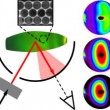Home > Press > Seeing the Light? Making Sense of Disorder in Polymer Opals
 |
Abstract:
The iridescent colours of natural opals have fascinated people for thousands of years. It is interesting, however, that the colours we see are generated only by diffraction of light between the ordered planes of atoms which make up the structures. In order to reproduce this effect in artificial systems and to allow such opal characteristics to be applied to, for example, flexible materials such as clothing or packaging, research into synthetic opals has gained momentum in the last decades.
Seeing the Light? Making Sense of Disorder in Polymer Opals
Germany | Posted on December 7th, 2012The diffraction of light from opal materials is very sensitive to the angle of reflection from the atomic planes within these materials, and variations in these angles can occur as a result of defects within the crystal structure. In order to fully characterize and understand the optical properties of synthesized opals it is important to be able to completely measure this angle-dependence; however, previously a technique to do this has been lacking.
Now, Andrew I. Haines and Jeremy J. Baumberg et al. have described a new way of measuring the three-dimensional angular scattering of light from nanostructures (hyperspectral goniometry technique), and use it to show that scattering from polymer opals, composed of ordered polymer nanospheres, is anisotropic. Specifically, light is scattered more broadly in the direction perpendicular to sample processing. They find that this effect is the result of chain defects, i.e., the presence of extra lines of polymer nanospheres, in the polymer-opal films tested; and that the enhanced colour observed when the structures are more highly ordered is due to an increased effective refractive-index contrast.
Furthermore, by doping these synthetic opal structures with light-absorbing carbon nanoparticles they discovered the colour saturation could be greatly improved as the nanoparticles absorb multiply scattered light so lower the background scattering without affecting the resonant scattering.
This research was reported in Advanced Optical Materials, a new section in Advanced Materials dedicated to breakthrough discoveries and fundamental research in photonics, plasmonics, metamaterials, and more, covering all aspects of light-matter interactions. Advanced Optical Materials will start as an independent journal in 2013. More information can be found on www.advopticalmat.de
####
For more information, please click here
Copyright © Wiley-VCH Materials Science Journals
If you have a comment, please Contact us.Issuers of news releases, not 7th Wave, Inc. or Nanotechnology Now, are solely responsible for the accuracy of the content.
| Related Links |
![]() Link to the original paper on Wiley Online Library:
Link to the original paper on Wiley Online Library:
| Related News Press |
News and information
![]() Researchers develop molecular qubits that communicate at telecom frequencies October 3rd, 2025
Researchers develop molecular qubits that communicate at telecom frequencies October 3rd, 2025
![]() Next-generation quantum communication October 3rd, 2025
Next-generation quantum communication October 3rd, 2025
![]() "Nanoreactor" cage uses visible light for catalytic and ultra-selective cross-cycloadditions October 3rd, 2025
"Nanoreactor" cage uses visible light for catalytic and ultra-selective cross-cycloadditions October 3rd, 2025
Discoveries
![]() Researchers develop molecular qubits that communicate at telecom frequencies October 3rd, 2025
Researchers develop molecular qubits that communicate at telecom frequencies October 3rd, 2025
![]() Next-generation quantum communication October 3rd, 2025
Next-generation quantum communication October 3rd, 2025
![]() "Nanoreactor" cage uses visible light for catalytic and ultra-selective cross-cycloadditions October 3rd, 2025
"Nanoreactor" cage uses visible light for catalytic and ultra-selective cross-cycloadditions October 3rd, 2025
Announcements
![]() Rice membrane extracts lithium from brines with greater speed, less waste October 3rd, 2025
Rice membrane extracts lithium from brines with greater speed, less waste October 3rd, 2025
![]() Researchers develop molecular qubits that communicate at telecom frequencies October 3rd, 2025
Researchers develop molecular qubits that communicate at telecom frequencies October 3rd, 2025
![]() Next-generation quantum communication October 3rd, 2025
Next-generation quantum communication October 3rd, 2025
![]() "Nanoreactor" cage uses visible light for catalytic and ultra-selective cross-cycloadditions October 3rd, 2025
"Nanoreactor" cage uses visible light for catalytic and ultra-selective cross-cycloadditions October 3rd, 2025
Textiles/Clothing
![]() Protective equipment with graphene nanotubes meets the strictest ESD safety standards March 25th, 2022
Protective equipment with graphene nanotubes meets the strictest ESD safety standards March 25th, 2022
![]() Polymer fibers with graphene nanotubes make it possible to heat hard-to-reach, complex-shaped items February 11th, 2022
Polymer fibers with graphene nanotubes make it possible to heat hard-to-reach, complex-shaped items February 11th, 2022
![]() Flexible material shows potential for use in fabrics to heat, cool July 3rd, 2020
Flexible material shows potential for use in fabrics to heat, cool July 3rd, 2020
Photonics/Optics/Lasers
![]() ICFO researchers overcome long-standing bottleneck in single photon detection with twisted 2D materials August 8th, 2025
ICFO researchers overcome long-standing bottleneck in single photon detection with twisted 2D materials August 8th, 2025
![]() Institute for Nanoscience hosts annual proposal planning meeting May 16th, 2025
Institute for Nanoscience hosts annual proposal planning meeting May 16th, 2025
|
|
||
|
|
||
| The latest news from around the world, FREE | ||
|
|
||
|
|
||
| Premium Products | ||
|
|
||
|
Only the news you want to read!
Learn More |
||
|
|
||
|
Full-service, expert consulting
Learn More |
||
|
|
||








